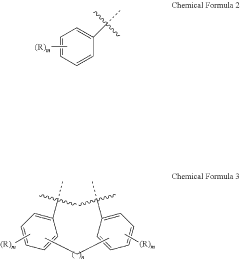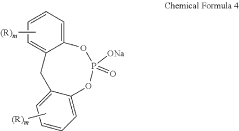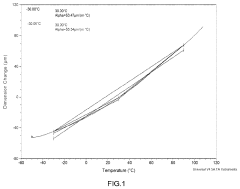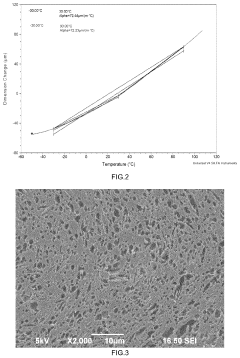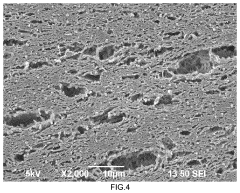Polycarbonate for Automotive Weight Reduction
JUL 1, 20259 MIN READ
Generate Your Research Report Instantly with AI Agent
Patsnap Eureka helps you evaluate technical feasibility & market potential.
Polycarbonate Automotive Applications
Polycarbonate has emerged as a key material in automotive applications, offering significant potential for weight reduction and enhanced performance. Its unique combination of properties, including high impact strength, optical clarity, and thermal stability, makes it an ideal candidate for various automotive components.
In exterior applications, polycarbonate is increasingly used for lightweight glazing solutions. Panoramic roofs, side windows, and rear windows made from polycarbonate can reduce vehicle weight by up to 50% compared to traditional glass. This weight reduction contributes to improved fuel efficiency and reduced emissions. Additionally, polycarbonate's design flexibility allows for more complex shapes and integrated functions, enhancing both aesthetics and aerodynamics.
Interior applications of polycarbonate are equally diverse and impactful. Instrument panels, center consoles, and interior trim components benefit from the material's durability and design freedom. Polycarbonate's ability to be molded into thin-wall structures enables the creation of lightweight, yet robust interior parts. Its scratch resistance and color stability ensure long-lasting aesthetics, while its inherent flame-retardant properties contribute to vehicle safety.
Lighting systems represent another significant area of polycarbonate application in automobiles. Headlamp lenses, taillight assemblies, and interior lighting fixtures leverage polycarbonate's optical clarity and impact resistance. The material's ability to transmit light efficiently while withstanding harsh environmental conditions makes it an excellent choice for these critical components. Moreover, the design flexibility of polycarbonate allows for innovative lighting solutions, such as integrated LED systems and complex lens geometries.
Under-the-hood applications are also benefiting from polycarbonate's properties. Engine covers, fluid reservoirs, and electrical connectors made from high-performance polycarbonate grades offer weight savings and improved thermal management. The material's resistance to automotive fluids and high temperatures ensures long-term reliability in these demanding environments.
Structural components, traditionally dominated by metals, are now seeing increased use of polycarbonate-based composites. These materials offer significant weight reduction potential while maintaining or even improving mechanical properties. Applications include body panels, bumper systems, and load-bearing structures. The use of polycarbonate composites in these areas not only reduces vehicle weight but also enhances crash performance and energy absorption capabilities.
As automotive manufacturers continue to push for lighter, more efficient vehicles, the role of polycarbonate is expected to expand further. Ongoing research and development efforts are focused on enhancing the material's properties, such as improving its scratch resistance, UV stability, and thermal performance. These advancements will likely open up new applications and further solidify polycarbonate's position as a critical material in automotive weight reduction strategies.
In exterior applications, polycarbonate is increasingly used for lightweight glazing solutions. Panoramic roofs, side windows, and rear windows made from polycarbonate can reduce vehicle weight by up to 50% compared to traditional glass. This weight reduction contributes to improved fuel efficiency and reduced emissions. Additionally, polycarbonate's design flexibility allows for more complex shapes and integrated functions, enhancing both aesthetics and aerodynamics.
Interior applications of polycarbonate are equally diverse and impactful. Instrument panels, center consoles, and interior trim components benefit from the material's durability and design freedom. Polycarbonate's ability to be molded into thin-wall structures enables the creation of lightweight, yet robust interior parts. Its scratch resistance and color stability ensure long-lasting aesthetics, while its inherent flame-retardant properties contribute to vehicle safety.
Lighting systems represent another significant area of polycarbonate application in automobiles. Headlamp lenses, taillight assemblies, and interior lighting fixtures leverage polycarbonate's optical clarity and impact resistance. The material's ability to transmit light efficiently while withstanding harsh environmental conditions makes it an excellent choice for these critical components. Moreover, the design flexibility of polycarbonate allows for innovative lighting solutions, such as integrated LED systems and complex lens geometries.
Under-the-hood applications are also benefiting from polycarbonate's properties. Engine covers, fluid reservoirs, and electrical connectors made from high-performance polycarbonate grades offer weight savings and improved thermal management. The material's resistance to automotive fluids and high temperatures ensures long-term reliability in these demanding environments.
Structural components, traditionally dominated by metals, are now seeing increased use of polycarbonate-based composites. These materials offer significant weight reduction potential while maintaining or even improving mechanical properties. Applications include body panels, bumper systems, and load-bearing structures. The use of polycarbonate composites in these areas not only reduces vehicle weight but also enhances crash performance and energy absorption capabilities.
As automotive manufacturers continue to push for lighter, more efficient vehicles, the role of polycarbonate is expected to expand further. Ongoing research and development efforts are focused on enhancing the material's properties, such as improving its scratch resistance, UV stability, and thermal performance. These advancements will likely open up new applications and further solidify polycarbonate's position as a critical material in automotive weight reduction strategies.
Market Demand Analysis
The automotive industry's push for weight reduction has significantly increased the demand for polycarbonate materials. This trend is driven by stringent fuel efficiency regulations and the growing emphasis on reducing carbon emissions. As automakers strive to meet these standards, they are increasingly turning to lightweight materials like polycarbonate to replace traditional metal components.
The global market for automotive polycarbonate is experiencing robust growth. This expansion is fueled by the material's unique combination of properties, including high impact resistance, thermal stability, and optical clarity. These characteristics make polycarbonate an ideal choice for various automotive applications, ranging from exterior components like headlamp lenses and body panels to interior parts such as instrument panels and center consoles.
In recent years, there has been a notable shift in consumer preferences towards more fuel-efficient and environmentally friendly vehicles. This shift has created a substantial market opportunity for polycarbonate manufacturers. The material's ability to contribute to weight reduction without compromising safety or performance aligns perfectly with these consumer demands.
The electric vehicle (EV) segment presents a particularly promising market for polycarbonate applications. As EV manufacturers seek to extend driving range and improve overall efficiency, the use of lightweight materials becomes crucial. Polycarbonate's potential to replace heavier materials in battery enclosures, body panels, and glazing applications positions it as a key enabler in the EV revolution.
Furthermore, the automotive industry's increasing focus on design flexibility and aesthetics has opened up new avenues for polycarbonate usage. The material's moldability and ability to integrate complex shapes and functions make it attractive for innovative design concepts, particularly in lighting systems and panoramic roofs.
The Asia-Pacific region, led by China and India, is expected to be the fastest-growing market for automotive polycarbonate. This growth is attributed to the rapid expansion of the automotive industry in these countries, coupled with increasing disposable incomes and changing consumer preferences. North America and Europe also continue to be significant markets, driven by stringent regulations and a strong focus on vehicle lightweighting.
However, the market faces challenges, including the high cost of polycarbonate compared to traditional materials and concerns about recyclability. These factors may impact adoption rates, particularly in price-sensitive markets. Nevertheless, ongoing research and development efforts are focused on addressing these challenges, potentially leading to more cost-effective and sustainable polycarbonate solutions for the automotive industry.
The global market for automotive polycarbonate is experiencing robust growth. This expansion is fueled by the material's unique combination of properties, including high impact resistance, thermal stability, and optical clarity. These characteristics make polycarbonate an ideal choice for various automotive applications, ranging from exterior components like headlamp lenses and body panels to interior parts such as instrument panels and center consoles.
In recent years, there has been a notable shift in consumer preferences towards more fuel-efficient and environmentally friendly vehicles. This shift has created a substantial market opportunity for polycarbonate manufacturers. The material's ability to contribute to weight reduction without compromising safety or performance aligns perfectly with these consumer demands.
The electric vehicle (EV) segment presents a particularly promising market for polycarbonate applications. As EV manufacturers seek to extend driving range and improve overall efficiency, the use of lightweight materials becomes crucial. Polycarbonate's potential to replace heavier materials in battery enclosures, body panels, and glazing applications positions it as a key enabler in the EV revolution.
Furthermore, the automotive industry's increasing focus on design flexibility and aesthetics has opened up new avenues for polycarbonate usage. The material's moldability and ability to integrate complex shapes and functions make it attractive for innovative design concepts, particularly in lighting systems and panoramic roofs.
The Asia-Pacific region, led by China and India, is expected to be the fastest-growing market for automotive polycarbonate. This growth is attributed to the rapid expansion of the automotive industry in these countries, coupled with increasing disposable incomes and changing consumer preferences. North America and Europe also continue to be significant markets, driven by stringent regulations and a strong focus on vehicle lightweighting.
However, the market faces challenges, including the high cost of polycarbonate compared to traditional materials and concerns about recyclability. These factors may impact adoption rates, particularly in price-sensitive markets. Nevertheless, ongoing research and development efforts are focused on addressing these challenges, potentially leading to more cost-effective and sustainable polycarbonate solutions for the automotive industry.
Current Challenges
The automotive industry faces several significant challenges in implementing polycarbonate for weight reduction. One of the primary obstacles is the material's high cost compared to traditional alternatives like steel and glass. This cost differential makes widespread adoption difficult, especially for mass-market vehicles where profit margins are often slim.
Another major challenge is the limited thermal stability of polycarbonate. At high temperatures, such as those experienced in automotive applications, polycarbonate can degrade, potentially compromising its structural integrity and optical properties. This limitation restricts its use in certain areas of the vehicle, particularly those exposed to high heat.
Durability and scratch resistance pose additional concerns. While polycarbonate offers excellent impact resistance, it is more susceptible to scratching and abrasion compared to glass. This vulnerability can lead to reduced visibility and aesthetics over time, particularly in areas like windows and headlamp covers.
The manufacturing and processing of polycarbonate components for automotive applications also present challenges. The material requires specialized molding techniques and equipment, which can be costly to implement. Additionally, achieving consistent quality and dimensional stability across large parts can be difficult, potentially leading to increased production costs and quality control issues.
Regulatory compliance and safety standards represent another hurdle. While polycarbonate has been approved for use in certain automotive applications, it must still meet stringent safety requirements, particularly for glazing applications. Ensuring compliance with these standards while maintaining the weight reduction benefits can be complex and time-consuming.
The automotive industry also faces challenges in recycling and end-of-life management of polycarbonate components. Unlike metals, which have well-established recycling processes, polycarbonate recycling is less developed and more complex, potentially impacting the material's overall environmental footprint.
Lastly, there are technical challenges related to joining and bonding polycarbonate components with other materials in the vehicle structure. Developing reliable and durable joining methods that can withstand the rigors of automotive use while maintaining the integrity of the polycarbonate is an ongoing area of research and development.
Another major challenge is the limited thermal stability of polycarbonate. At high temperatures, such as those experienced in automotive applications, polycarbonate can degrade, potentially compromising its structural integrity and optical properties. This limitation restricts its use in certain areas of the vehicle, particularly those exposed to high heat.
Durability and scratch resistance pose additional concerns. While polycarbonate offers excellent impact resistance, it is more susceptible to scratching and abrasion compared to glass. This vulnerability can lead to reduced visibility and aesthetics over time, particularly in areas like windows and headlamp covers.
The manufacturing and processing of polycarbonate components for automotive applications also present challenges. The material requires specialized molding techniques and equipment, which can be costly to implement. Additionally, achieving consistent quality and dimensional stability across large parts can be difficult, potentially leading to increased production costs and quality control issues.
Regulatory compliance and safety standards represent another hurdle. While polycarbonate has been approved for use in certain automotive applications, it must still meet stringent safety requirements, particularly for glazing applications. Ensuring compliance with these standards while maintaining the weight reduction benefits can be complex and time-consuming.
The automotive industry also faces challenges in recycling and end-of-life management of polycarbonate components. Unlike metals, which have well-established recycling processes, polycarbonate recycling is less developed and more complex, potentially impacting the material's overall environmental footprint.
Lastly, there are technical challenges related to joining and bonding polycarbonate components with other materials in the vehicle structure. Developing reliable and durable joining methods that can withstand the rigors of automotive use while maintaining the integrity of the polycarbonate is an ongoing area of research and development.
Existing Solutions
01 Molecular weight control of polycarbonates
Various methods are employed to control the molecular weight of polycarbonates during synthesis. These techniques may involve adjusting reaction conditions, using specific catalysts, or adding chain terminators. Controlling molecular weight is crucial for achieving desired physical and mechanical properties in polycarbonate materials.- Molecular weight control of polycarbonates: Various methods are employed to control the molecular weight of polycarbonates during synthesis. These techniques may involve adjusting reaction conditions, using specific catalysts, or adding chain terminators. Controlling molecular weight is crucial for achieving desired physical and mechanical properties in polycarbonate materials.
- Light-weight polycarbonate compositions: Development of light-weight polycarbonate compositions involves incorporating additives or modifying the polymer structure to reduce overall density while maintaining desirable properties. These formulations are particularly useful in applications where weight reduction is critical, such as automotive and aerospace industries.
- High molecular weight polycarbonates: Synthesis of high molecular weight polycarbonates aims to enhance mechanical strength, thermal stability, and impact resistance. Specialized polymerization techniques and careful control of reaction parameters are employed to achieve higher molecular weights without compromising processability.
- Weight reduction in polycarbonate blends: Blending polycarbonates with other polymers or incorporating fillers can lead to weight reduction while maintaining or improving specific properties. These blends often aim to combine the advantages of multiple materials, resulting in lightweight composites with tailored characteristics.
- Polycarbonate weight optimization for specific applications: Tailoring polycarbonate weight for specific applications involves adjusting molecular weight, incorporating additives, or modifying processing conditions. This approach ensures optimal performance in various fields such as electronics, automotive, and consumer goods, where weight considerations are crucial.
02 Lightweight polycarbonate compositions
Development of lightweight polycarbonate compositions involves incorporating additives or modifying the polymer structure to reduce overall density while maintaining desirable properties. These lightweight materials find applications in automotive, aerospace, and consumer electronics industries where weight reduction is critical.Expand Specific Solutions03 Polycarbonate blends for weight reduction
Blending polycarbonates with other polymers or materials can result in weight reduction while preserving or enhancing certain properties. These blends may offer improved impact resistance, heat resistance, or processability compared to pure polycarbonates, making them suitable for various applications.Expand Specific Solutions04 Weight-average molecular weight determination
Techniques for determining the weight-average molecular weight of polycarbonates are essential for quality control and property prediction. Methods such as gel permeation chromatography (GPC) or light scattering are commonly used to measure and characterize the molecular weight distribution of polycarbonate samples.Expand Specific Solutions05 Impact of molecular weight on polycarbonate properties
The molecular weight of polycarbonates significantly influences their physical, mechanical, and thermal properties. Understanding this relationship is crucial for tailoring polycarbonates to specific applications. Higher molecular weights generally result in improved toughness and heat resistance, while lower molecular weights may offer better processability.Expand Specific Solutions
Key Industry Players
The automotive weight reduction market using polycarbonate is in a growth phase, driven by increasing demand for fuel-efficient vehicles and stringent emissions regulations. The global market size is expanding, with projections indicating significant growth in the coming years. Technologically, polycarbonate for automotive applications is relatively mature, with ongoing innovations focused on enhancing performance and reducing costs. Key players like Covestro, SABIC, and Bayer are at the forefront, leveraging their extensive R&D capabilities and global presence. Emerging companies such as Kingfa and PRET are also making strides, particularly in the Asian market. The competitive landscape is characterized by collaborations between material suppliers and automotive manufacturers, as seen with partnerships involving companies like Hyundai and Kia.
Covestro Deutschland AG
Technical Solution: Covestro has developed innovative polycarbonate blends specifically for automotive weight reduction. Their Makrolon® polycarbonate grades offer up to 50% weight savings compared to traditional materials like glass or metal[1]. They have also introduced Makrolon® RE, a more sustainable polycarbonate made with up to 71% bio-circular raw materials[2]. Covestro's continuous fiber-reinforced thermoplastic composites (CFRTP) combine polycarbonate with carbon or glass fibers, providing high strength-to-weight ratios ideal for structural components[3]. Their polycarbonate glazing solutions for panoramic roofs and rear windows can reduce weight by up to 40% versus glass[4].
Strengths: Industry-leading expertise in polycarbonate, wide range of specialized automotive grades, focus on sustainability. Weaknesses: Higher cost compared to some competing materials, may require new processing techniques for manufacturers.
SABIC Global Technologies BV
Technical Solution: SABIC has developed LEXAN™ polycarbonate resins and XENOY™ polycarbonate/polybutylene terephthalate blends for automotive weight reduction. Their LEXAN™ resin can reduce weight by up to 50% compared to glass in glazing applications[1]. SABIC's Functional Forms portfolio includes LEXAN™ CLINIWALL™ sheet and LEXAN™ MARGARD™ sheet for interior and exterior automotive parts respectively[2]. They have also introduced NORYL™ GTX resin, a blend of polyphenylene ether (PPE) and polyamide (PA) for exterior body panels, offering up to 40% weight savings over steel[3]. SABIC's continuous fiber reinforced thermoplastic composite tapes (CFRTC) combine polycarbonate with carbon or glass fibers for structural components[4].
Strengths: Diverse portfolio of polycarbonate-based solutions, strong focus on both interior and exterior applications. Weaknesses: May face competition from newer, more specialized materials in certain applications.
Core Innovations
Thermoplastic resin composition having high rigidity and low coefficient of linear thermal expansion and molded article comprising same
PatentActiveUS11999841B2
Innovation
- A thermoplastic resin composition comprising a first and second propylene-ethylene copolymer, a thermoplastic elastomer, an inorganic filler, and a sodium-phosphate-based nucleating agent, which provides a balance of mechanical rigidity, impact resistance, and dimensional stability while allowing for thin-part molding with reduced weight.
Polyolefin resin composition having high rigidity and low coefficient of linear thermal expansion and weight-reduced automobile part comprising same
PatentActiveUS11905402B2
Innovation
- A thermoplastic resin composition comprising a high-crystalline polypropylene-based resin, a thermoplastic elastomer, an inorganic filler, and a compatibilizer, with specific properties such as a flexural modulus of 2,500 MPa or more and a low coefficient of linear thermal expansion, to achieve improved mechanical properties and dimensional stability.
Environmental Impact
The use of polycarbonate for automotive weight reduction has significant environmental implications that extend beyond the immediate benefits of improved fuel efficiency and reduced emissions during vehicle operation. The production process of polycarbonate involves energy-intensive methods and petrochemical feedstocks, which contribute to greenhouse gas emissions and resource depletion. However, advancements in manufacturing techniques and the potential for using bio-based precursors are gradually mitigating these environmental concerns.
When compared to traditional materials like steel and glass, polycarbonate offers a lower carbon footprint over the entire lifecycle of a vehicle. The reduced weight of polycarbonate components leads to decreased fuel consumption and, consequently, lower CO2 emissions throughout the vehicle's operational life. Studies have shown that for every 100 kg reduction in vehicle weight, CO2 emissions can be reduced by approximately 8.5 g/km.
Polycarbonate's durability and resistance to weathering contribute to extended product lifespans, reducing the need for frequent replacements and the associated environmental impact of manufacturing new parts. Additionally, the material's recyclability presents opportunities for closed-loop systems in the automotive industry, further reducing waste and resource consumption.
However, the end-of-life management of polycarbonate components poses challenges. While theoretically recyclable, the complex compositions of automotive parts often make separation and recycling difficult in practice. Efforts are underway to develop more efficient recycling technologies and to design components with easier disassembly and material recovery in mind.
The use of polycarbonate also raises concerns about the release of microplastics into the environment through wear and tear during a vehicle's lifetime. Research is ongoing to assess the extent of this issue and to develop potential mitigation strategies, such as surface treatments or alternative formulations that reduce particle shedding.
From a broader perspective, the shift towards polycarbonate in automotive applications aligns with global efforts to reduce transportation-related emissions and improve energy efficiency. As the automotive industry transitions towards electric and hybrid vehicles, the weight reduction enabled by polycarbonate becomes even more critical in extending range and improving overall environmental performance.
In conclusion, while the environmental impact of polycarbonate in automotive applications is complex, the material's potential to contribute to significant weight reduction and consequent emissions reductions over a vehicle's lifetime presents a compelling case for its increased adoption. Ongoing research and development efforts are focused on addressing the remaining environmental challenges associated with production and end-of-life management, aiming to further enhance the sustainability profile of polycarbonate in the automotive sector.
When compared to traditional materials like steel and glass, polycarbonate offers a lower carbon footprint over the entire lifecycle of a vehicle. The reduced weight of polycarbonate components leads to decreased fuel consumption and, consequently, lower CO2 emissions throughout the vehicle's operational life. Studies have shown that for every 100 kg reduction in vehicle weight, CO2 emissions can be reduced by approximately 8.5 g/km.
Polycarbonate's durability and resistance to weathering contribute to extended product lifespans, reducing the need for frequent replacements and the associated environmental impact of manufacturing new parts. Additionally, the material's recyclability presents opportunities for closed-loop systems in the automotive industry, further reducing waste and resource consumption.
However, the end-of-life management of polycarbonate components poses challenges. While theoretically recyclable, the complex compositions of automotive parts often make separation and recycling difficult in practice. Efforts are underway to develop more efficient recycling technologies and to design components with easier disassembly and material recovery in mind.
The use of polycarbonate also raises concerns about the release of microplastics into the environment through wear and tear during a vehicle's lifetime. Research is ongoing to assess the extent of this issue and to develop potential mitigation strategies, such as surface treatments or alternative formulations that reduce particle shedding.
From a broader perspective, the shift towards polycarbonate in automotive applications aligns with global efforts to reduce transportation-related emissions and improve energy efficiency. As the automotive industry transitions towards electric and hybrid vehicles, the weight reduction enabled by polycarbonate becomes even more critical in extending range and improving overall environmental performance.
In conclusion, while the environmental impact of polycarbonate in automotive applications is complex, the material's potential to contribute to significant weight reduction and consequent emissions reductions over a vehicle's lifetime presents a compelling case for its increased adoption. Ongoing research and development efforts are focused on addressing the remaining environmental challenges associated with production and end-of-life management, aiming to further enhance the sustainability profile of polycarbonate in the automotive sector.
Safety Regulations
Safety regulations play a crucial role in the adoption of polycarbonate for automotive weight reduction. As vehicle manufacturers strive to improve fuel efficiency and reduce emissions, the use of lightweight materials like polycarbonate has gained significant attention. However, the implementation of these materials must adhere to stringent safety standards to ensure passenger protection and overall vehicle safety.
In the United States, the National Highway Traffic Safety Administration (NHTSA) sets and enforces safety performance standards for motor vehicles. The Federal Motor Vehicle Safety Standards (FMVSS) include specific requirements for glazing materials, which directly impact the use of polycarbonate in automotive applications. FMVSS 205, in particular, addresses glazing materials and their installation in vehicles.
The European Union has similar regulations in place, with the United Nations Economic Commission for Europe (UNECE) Regulation No. 43 governing the approval of safety glazing materials and their installation on vehicles. These regulations ensure that polycarbonate components meet specific impact resistance, optical clarity, and durability requirements.
One of the primary safety concerns for polycarbonate in automotive applications is its performance in crash scenarios. Regulations require that these materials maintain their structural integrity during impacts and prevent passenger ejection. Manufacturers must demonstrate compliance through rigorous testing procedures, including impact resistance tests and weathering simulations.
Another critical aspect of safety regulations for polycarbonate in automotive use is its fire resistance properties. Materials used in vehicle interiors must meet specific flammability standards to minimize the risk of fire spread in the event of an accident. This requirement has led to the development of flame-retardant polycarbonate formulations that comply with safety regulations while maintaining the material's lightweight properties.
Visibility and optical clarity are also essential factors addressed by safety regulations. Polycarbonate used in windows and windshields must meet strict standards for light transmission, haze, and distortion. These requirements ensure that drivers have clear visibility under various lighting conditions and weather scenarios.
As the automotive industry continues to innovate with lightweight materials, safety regulations are evolving to keep pace. Regulatory bodies are working closely with manufacturers and material suppliers to develop new testing methodologies and performance criteria specifically tailored to polycarbonate and other advanced materials. This collaborative approach aims to balance the benefits of weight reduction with the paramount importance of vehicle safety.
In conclusion, safety regulations serve as a critical framework for the integration of polycarbonate in automotive weight reduction efforts. By ensuring compliance with these standards, manufacturers can leverage the benefits of lightweight materials while maintaining the highest levels of passenger safety and vehicle performance.
In the United States, the National Highway Traffic Safety Administration (NHTSA) sets and enforces safety performance standards for motor vehicles. The Federal Motor Vehicle Safety Standards (FMVSS) include specific requirements for glazing materials, which directly impact the use of polycarbonate in automotive applications. FMVSS 205, in particular, addresses glazing materials and their installation in vehicles.
The European Union has similar regulations in place, with the United Nations Economic Commission for Europe (UNECE) Regulation No. 43 governing the approval of safety glazing materials and their installation on vehicles. These regulations ensure that polycarbonate components meet specific impact resistance, optical clarity, and durability requirements.
One of the primary safety concerns for polycarbonate in automotive applications is its performance in crash scenarios. Regulations require that these materials maintain their structural integrity during impacts and prevent passenger ejection. Manufacturers must demonstrate compliance through rigorous testing procedures, including impact resistance tests and weathering simulations.
Another critical aspect of safety regulations for polycarbonate in automotive use is its fire resistance properties. Materials used in vehicle interiors must meet specific flammability standards to minimize the risk of fire spread in the event of an accident. This requirement has led to the development of flame-retardant polycarbonate formulations that comply with safety regulations while maintaining the material's lightweight properties.
Visibility and optical clarity are also essential factors addressed by safety regulations. Polycarbonate used in windows and windshields must meet strict standards for light transmission, haze, and distortion. These requirements ensure that drivers have clear visibility under various lighting conditions and weather scenarios.
As the automotive industry continues to innovate with lightweight materials, safety regulations are evolving to keep pace. Regulatory bodies are working closely with manufacturers and material suppliers to develop new testing methodologies and performance criteria specifically tailored to polycarbonate and other advanced materials. This collaborative approach aims to balance the benefits of weight reduction with the paramount importance of vehicle safety.
In conclusion, safety regulations serve as a critical framework for the integration of polycarbonate in automotive weight reduction efforts. By ensuring compliance with these standards, manufacturers can leverage the benefits of lightweight materials while maintaining the highest levels of passenger safety and vehicle performance.
Unlock deeper insights with Patsnap Eureka Quick Research — get a full tech report to explore trends and direct your research. Try now!
Generate Your Research Report Instantly with AI Agent
Supercharge your innovation with Patsnap Eureka AI Agent Platform!

